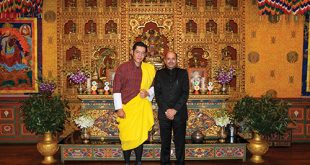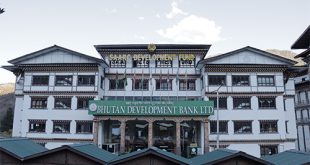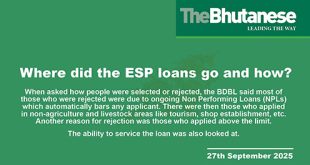Price of Ferro Silicon is currently below the cost of production
For many years, ferro silicon or ferro products have been Bhutan’s top export item, and also one of the most profitable industries with huge highs seen in 2022 and 2023 with record breaking profits.
The revenue and the profits have led to a ferro rush of sorts with 9 factories coming up in Norbugang, Samtse with billions in investments, the majority of which are loans sourced from Bhutanese financial institutions.
If the factories do well then there will be billions in revenue and profits, billions in tax revenue, a spike in foreign currency earnings and thousands of jobs created. However, if they don’t do well due to international prices, cost of production and other issues then billions are at stake for the Bhutanese economy.
Nu 13 to 15 bn worth of Ferro factories coming up
To get a scale of what is happening, 11 existing ferro factories produced around 145,675 tons of ferro silicon worth Nu 15.061 billion (bn) and 17,890 tons of ferro silicon manganese worth Nu 2.715 bn in 2024. These were built in stages all the way from the first one in Bhutan Ferro Alloys Limited (BFAL) in 1990 to the latest entries coming in as recently as 2024.
The 9 ferro industries in Norbugang that are coming up, once mainly completed by this year and next year, will produce 218,000 tons of ferro silicon and 50,000 tons of Ferro Silico Manganese.
The total value of these 9 factories coming up are around a jaw dropping Nu 13 bn in investments and most of these are around 40 percent equity which is the money of FDI partners and Bhutanese promoters while around 60 percent is debt.
This means that around Nu 7.8 bn will have to come from Bhutanese banks as loans to the projects.
Data from the RMA shows that Nu 6.2 bn has been sanctioned for ferro silicon companies, not counting the 1 ferro manganese plant in Norbugang. The Nu 6.2 bn is likely an underestimate as some financial institutions may not have given proper sub-classification while submitting the loan data break up or other types of loans going to these plants like working capital etc., may not be included. A banker confirmed that actual loan will be well above Nu 6.2 bn.
In terms of their size they are B.V Ferro Alloys (60 MW or 60 MVA) at Nu 2.5 bn , DV Ferro Alloys (60 MVA) at Nu 2.5 bn, Exalt (36 MVA) at Nu 2 bn, Ace Himalayan (32 MVA) at Nu 1.6 bn, Aja Alloys (18 MVA) at Nu 750 mn, BMML (36 MVA) at Nu 1 bn plus, Green Ferro Alloys (26 MVA) at Nu 1.03 bn producing Ferro Manganese, Samtse Ferro Alloys (40 MVA) at Nu 1 bn plus and Om Jigmeling (22.2 MVA) at or under Nu 1 bn.
Of the above, only BMML, Samtse and Ace are not FDIs with the rest having FDI partners between 75 percent and 50 percent from India.
There are still three plots vacant for which 8 companies are competing, and once these are allotted then the total size of the Norbugang could be 12 companies, and the financial worth would well cross Nu 15 bn.
Apart from the above, the Bhutan Power Corporation has spent Nu 3.6 bn building around 300 MW of substations which will be augmented to 400 MW soon. The Department of Industry has invested around Nu 800 mn for the Industrial Estate with river training works and basic infrastructure.
Concerns
Some Ferro Industry manufacturers and experts that the paper talked to have concerns.
A person familiar with the industry said, “The hefty profits provoked by shortages due to the pandemic are gone and with geo-political tensions and other factors ferro prices have come down, and are now spiraling downwards. Around 30 percent of the ferro silicone production cost is the electricity cost. Currently we import power from India for up to 6 months in a year with much higher tariff rates. There are also issues on prices of raw materials, etc.”
From the start of the ferro silicon industry in 1990 till 2024 the sector, as a whole, almost always made profits every year with some years better than others, and even if there were small slumps in the year, the price increases in the later part of the year made up for it.
However, in 2025 a very different phenomenon is playing out as the main ferro silicon market in India has seen a slump in prices, which according to some ferro manufacturers are below the cost of production even.
An official with a ferro plant said that the cost of production of ferro silicone is around Nu 86,000 to 90,000 per ton and so prices need to stay above that for industries to do well.
The year started well enough with around Nu 103,900 per ton in India, but it then declined to Nu 94,700 in May to Nu 88,600 by June and even lower to Nu 86,800 per ton by mid-July.
The official said that the cost of production for the upcoming new plants in Norbugang will be even higher with new infrastructure, equipment, higher financing cost, loans, etc., and there the cost of production will be Nu 90,000 plus per ton.
A ferro expert said that if the current price trends continue then the ferro Industry will likely make a loss overall in 2025 which will be very rare in its history.
The ferro expert is also worried about a price war and a race to the bottom with so much ferro silicon capacity coming online in a short time.
India, for all its size, produced only 60,000 tons of ferro silicon in 2024 compared to Bhutan’s 145,675 tons with the main market being India.
With prices already low, the worry is that with 218,000 tons of ferro silicon entering the market from the later half of this year to next year, it could increase supply even more depressing prices unless there is a substantial increase in demand.
A related worry, according to ferro industry insider, is an absolute inability among the current players to cooperate and dictate the export price with price cutting common among them. This was even in the good times when prices were high.
Apart from lower prices, a big worry is also on the electricity prices, which is only going to get higher as July 2025 is the time for the 3-year power tariff review, with the Druk Green Power Corporation (DGPC) and BPC submitting for an increase in the power tariff. The tariff for High Voltage users is around Nu 2.93 per unit including the demand charge.
BPC and DGPC are seeking an increase due to inflation and increased operation and maintenance costs. The additional factor for BPC is demand for more lines and reliability, and for DGPC the new hydro projects that are being commissioned have a higher generating cost since their cost of construction is higher due to inflation.
New investors say they have done their calculations
The above may paint a stark picture, but that is only one side of the debate.
An investor in one of the Norbugang plants said that since the main market for ferro silicon and ferro products is India where it is used in steel production, the important data to note is Indian steel production.
In 2010 India produced 68.3 mn tons of steel as the world’s fourth largest producer while Bhutan exported 88,812 tons of ferro silicon mainly to India. In 2024 India jumped to 149.4 mn tons of steel, and Bhutan exported 145,675 tons of ferro silicon.
This above shows that Indian steel production grew faster in the last 14 years than Bhutan’s ferro silicon production.
The investor said that India’s target is 300 mn tons by 2030 and it is on its way to achieve it or get close to it, which will only mean more demand for ferro silicon.
A government official said that the doom and gloom predictions are being made by some of the current ferro silicon factories, and asked, if that is the case then why are many of the current ones expanding their capacity?
On the issue of power costs, the Norbugang investor said during last winter, power was only imported for the five months; November, December, January, February and March, as rains in April 2025 ensured no imports. He said that the last two years, during which power had to be imported for six months, were outliers caused by unusual hydrology, whereas in the past 12 years, power generation had consistently exceeded projections due to better-than-expected hydrology.
In the case of the higher tariff proposed by BPC and DGPC, the investor said that during the time of the last government, they provided an annual subsidy of Nu 1.3 bn to low voltage households. However, of the Nu 1.3 bn subsidy the tariff was changed and the Nu 1 bn subsidy cost was shifted to the Heavy Voltage consumers who saw an additional 30 chetrums being added to them by the then Cabinet above what BPC, DGPC and the erstwhile Bhutan Electricity Authority (BEA) proposed. He said if the tariff revision is fair and scientific this time then it should either come down, remain the same or go up only slightly for HV consumers.
The investor said that in the winter months, Bhutan, instead of importing power from the day ahead market, which is very expensive, should look at importing power through the much cheaper long-term power purchase agreements for these months which only the government can do.
The investor said there are new technologies that can be used in the upcoming Norbugang plants that can make them more power efficient and the plants should also consider carbon trading since every ton of Bhutanese ferro silicon only generates 4 tons of carbon dioxide compared to 11 tons in India due to the renewable energy source in Bhutan.
A ferro manager in Norbugang said while it is true that ferro silicon prices are down right now, it also means that raw material prices like charcoal, etc., is also coming down. He said earlier semi coke from China was USD 215 and now it is USD 180 and charcoal was earlier Nu 30,000 per ton but it is now Nu 24,000 per ton.
On the issue of price, another investor in Norbugang said currently, prices are low since it is monsoon when there is reduced construction and hence reduced demand for steel, but it will pick up in the coming months. He said this happens every year.
The second investor said that ferro silicon is a cyclical business with ups and downs which has always been the case. He said by 2008 a lot of ferro plants had come in and they all made money, but in 2009 they all lost money due to the global financial crisis reducing global demand.
The government official said that the advantage of so many Bhutanese ferro companies is that Bhutan will be a substantial supplier, and if they come together then they can influence the markets. The official said there had been some discussion in the government to limit the numbers, but it was decided to given them the benefit of the doubt on the assumption that the investors and their FDI partners from India would have done their homework, and in the long term, the steel demand is only set to rise and along with that the demand for ferro silicon and ferro products.
The reporter asked the first investor if the ferro Industries may end up like the hotels, with people rushing in because they saw others making money and then over capacity developing. The investor said the hotel comparison does not hold, as hotels until the pandemic were all doing well, but Bhutan decided to value other things more and so the hotels are in a fix, which will not happen to the ferro industry.
The second investor said what is more likely to happen is that smaller and less competitive units in India may go out of business. The ferro manager also agreed that some players may go out due to the competition, but it is hoped this does not happen in Bhutan, and it happens to players outside Bhutan.
A lot of what happens in the ferro silicon sector will also be determined not only in Bhutan and India, but also demand and production in the larger global steel market with the largest producer of steel being China accounting for 50 percent of global steel output. Second, is India followed by Japan, USA, Russia, South Korea, Turkey, Germany, Brazil, etc.
When it comes to ferro silicon, the world’s largest producer making more than 80 percent of the global production is China at around 3.5 million tons a year, followed by Malaysia, Russia, Brazil, Norway and Kazakhstan. Bhutan is also on the top 10 global list. What happens in this market also matters for Bhutan.
While India is the main market for Bhutan’s ferro silicon, there are also other exports markets, like Europe, USA, Australia, South Korea, etc.
 The Bhutanese Leading the way.
The Bhutanese Leading the way.




